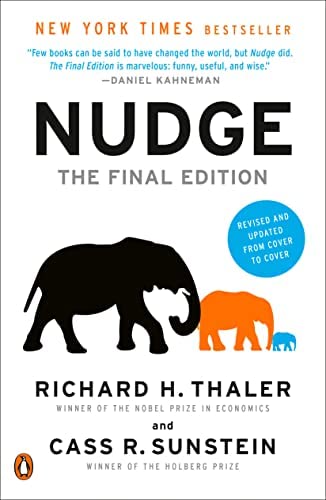“Nudge: The Final Edition”
By Richard Thaler and Cass Sunstein
First published in 2009, “Nudge: Improving Decisions About Health, Wealth, and Happiness” introduced a concept that seemed like a radical departure from conventional wisdom: Even the smartest, most informed person is susceptible to influence, and there is no such thing as true “freedom of choice.” Someone — the government, corporations, social networks — always has a finger on the scale. For individuals, the best way to ensure you are making sound decisions is to recognize the role of that influence on your thinking. And organizations that present choices to individuals must acknowledge the power they hold over outcomes.
Following its enormous impact on business and policymakers, the 2021 edition of “Nudge” has been updated with new research in economics and behavioral science, as well as the lessons learned — or “learned” — from the evolving pandemic response. As Adam Grant says in a blurb, “Nudge” has become “the gold standard for using behavioral science to guide decisions.”
Thaler, winner of the 2017 Nobel Prize in Economics for his contributions to the field of behavioral economics, and Sunstein, Robert Walmsley University Professor at Harvard Law School and former White House Administrator of the Office of Information and Regulatory Affairs, explain anew what they mean by “nudge theory,” how consumers can use it to make better decisions and how organizations can fully appreciate the responsibility they bear in making that happen. Here are the takeaways:
People are busy and have limited attention, and their reasoning is far from perfect. Researchers have identified common flaws in decision-making and shone a light on social factors that influence choices, such as traditions, norms and identity. Traditional libertarians may recoil at this line of thinking — don’t we all have freedom of choice? — but Thaler and Sunstein argue that such a neutral context does not actually exist. “Libertarian Paternalism,” an intentional oxymoron, is the best we can get. Institutions can and should seek to influence behavior while still respecting freedom of choice.
Institutions — governments, corporations and other groups — are “choice architects.” They create the context in which people make decisions and, with a proper understanding of human behavior, can “nudge” those people into preferred choices. The authors explore a slate of examples around personal finance that illustrate their theory. People are more likely to save money in a 401k if enrollment is automatic and people must actively opt out to avoid it, rather than needing to opt in. People riding in cabs are far more likely to tip when using a credit card interface that presents three options — a tip of 5%, 15% and 20% — instead of no suggestions at all.
Best practices in choice architecture are pretty basic. And powerful. When you want to nudge someone toward a choice that is good for them (and possibly for you), start by considering the number of choices you present (and which choices you omit), the way you describe these choices and which option you frame as the default. You might also think about sharing information on how the chooser’s peers behaved in the face of similar options. One of the most powerful hacks for parents of toddlers is creating the illusion of choice: “Do you want to go to bed now or in five minutes?” The child feels victorious, but either way the parent gets what she wants in the end. Adults like to think we would not fall for a similar trick, but the data says otherwise.
Choice architecture is not the same as manipulation, assuming you have good intentions. And therein lies a potential problem with Nudge’s argument. Institutions and people with influence, from policymakers to advertising directors, may create decision contexts based on a sophisticated understanding of typical biases that impact people’s choices. But that doesn’t mean they are fully aware of their own assumptions about what is in a person’s best interest. Individuals vary in what they value, what they desire and, most importantly, why, and true personal freedom means allowing people to make bad decisions for their own mysterious reasons.
Yet in a world (this one!) where the bad decisions of individuals have consequences for other people (not wearing masks during a pandemic, failing to save for retirement and requiring government aid, treating a client so poorly she takes her business to another firm), arguing against choice architecture seems, at best, naïve.
If you are a choice architect, it is within your power and your responsibility to try to get people to make choices that are good for them. Because if you don’t exercise influence over their decision, somebody else will.

